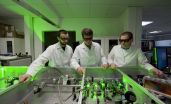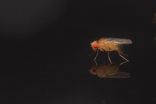(Press-News.org) Action-packed science-fiction movies often feature colourful laser bolts. But what would a real laser missile look like during flight, if we could only make it out? How would it illuminate its surroundings? The answers lie in a film made at the Laser Centre of the Institute of Physical Chemistry of the Polish Academy of Sciences in cooperation with the Faculty of Physics at the University of Warsaw.
Tests of a new compact high-power laser have given researchers at the Laser Centre of the Institute of Physical Chemistry of the Polish Academy of Sciences and the Faculty of Physics, University of Warsaw (IPC PAS and FUW) the opportunity to film the passage of an ultrashort laser pulse through the air. The film shows the journey of a light projectile at an extremely slow rate, similar to that watched on cinema screens by science-fiction aficionados.
"If you wanted to film a single light impulse to move as slowly on film as in our recording, you would have to use a camera operating at a speed of a billion frames per second", says Dr. Yuriy Stepanenko, leading the team responsible for the construction of the laser.
Cameras recording billions of frames per second in one sequence do not exist. In order to film the travelling laser pulse, researchers from the Laser Centre of IPC PAS and FUW used an earlier known trick. A suitably adapted camera was synchronised with a laser generating laser pulses at a rate of approx. 10 shots per second. It was done in such a way that with every subsequent pulse the camera recorded an image minimally delayed than previous one.
"In fact, a different laser pulse can be seen in every frame of our film", explains Dr. Paweł Wnuk, (LC of IPC PAS and FUW) and adds: "Luckily, the physics always stays the same. So, on the film one can observe all the effects associated with the movement of the laser pulse in space, in particular, the changes in ambient light depending on the position of the pulse and the formation of flares on the walls when the light passes through the dispersing cloud of condensed water vapour".
The laser pulse, lasting a dozen or so femtoseconds (millionths of a billionth of a second), was generated by a laser constructed at the Laser Centre of IPC PAS and FUW. It was so powerful that it almost immediately ionised the atoms it encountered. As a result, a plasma fibre – filament – was formed alongside the pulse. By appropriately selecting the operating parameters of the laser, to permit a balance of the complex interactions between the pulse's electromagnetic field and the plasma filament, the laser light beam did not disperse in the air, conversely, it underwent self-focusing. This meant that the pulse could effectively move a much greater distance than low-power pulses, whilst maintaining its original parameters.
"It is worth noting that although the light we are shooting from the laser is in the near infrared range, a laser beam like this travelling through the air changes colour to white. This happens since the interaction of the pulse with the plasma generates light of many different wavelengths. Received simultaneously, these waves give the impression of white", adds Dr. Stepanenko.
The ability of the light pulses from the new laser to penetrate the atmosphere over long distances is a feature that the Warsaw researchers made use of when demonstrating LIDAR, a device that can be used for the remote testing of atmospheric pollution. The fact that the pulses generate white light during passage is an important advantage in this context. Light at different wavelengths interacting with the atoms and molecules in the air is able to provide a far greater wealth of information. This means that LIDAR constructed using the new laser will be able to detect a larger number of elements and compounds polluting the atmosphere.
Photos and films of the ballistic laser pulse and plasma filaments were shot during testing of the compact laser generating femtosecond pulses with a power of over 10 terawatts, constructed at the Laser Centre of IPC PAS and FUW. The innovative device uses the direct transfer of energy from the pump laser beam to the reinforced beam. Due to the effects of nonlinear optics the light is amplified hundreds of millions of times on a distance of just a few centimetres with over 30% efficiency, which is outstanding among devices of this class. The multi-pass optical parametric amplifier NOPCPA (Noncollinear Optical Parametric Chirped Pulse Amplifier) used in the laser was designed in-house and Prof. Czesław Radzewicz and his team have been developing it in the Laser Centre of IPC and FUW since 2005.
INFORMATION:
The Institute of Physical Chemistry of the Polish Academy of Sciences was established in 1955 as one of the first chemical institutes of the PAS. The Institute's scientific profile is strongly related to the newest global trends in the development of physical chemistry and chemical physics. Scientific research is conducted in nine scientific departments. CHEMIPAN R&D Laboratories, operating as part of the Institute, implement, produce and commercialise specialist chemicals to be used, in particular, in agriculture and pharmaceutical industry. The Institute publishes approximately 200 original research papers annually.
"We're using less expensive raw materials in smaller amounts, we have fewer production steps, and have potentially lower total energy consumption," PhD candidate Fredrik Martinsen and Professor Ursula Gibson of the Department of Physics at NTNU explain.
They recently published their technique in Scientific Reports.
Their processing technique allows them to make solar cells from silicon that is 1000 times less pure, and thus less expensive, than the current industry standard.
Glass fibers with a silicon core
The researchers' solar cells are composed of silicon fibers ...
Bright colours appear on a fruit fly's transparent wings against a dark background as a result of light refraction. Researchers from Lund University in Sweden have now demonstrated that females choose a mate based on the males' hidden wing colours.
"Our experiment shows that this newly-discovered trait is important in female choice in fruit flies, and is the first evidence that wing interference patterns have a biological signalling function between the sexes during sexual selection", said Jessica Abbott, a biologist at Lund University.
The extremely thin wings of the ...
DURHAM, N.C. -- Doctors at Duke University Hospital have developed a new collaborative model in cancer care that reduced the rates at which patients were sent to intensive care or readmitted to the hospital after discharge.
The Duke researchers shared their findings today at the Palliative Care in Oncology Symposium sponsored by the American Society of Clinical Oncology.
In the new treatment model, medical oncologists and palliative care physicians partnered in a "co-rounding" format to deliver cancer care for patients admitted to Duke University Hospital's solid tumor ...
Predicting which people will commit murder is extremely difficult, according to a new study by criminologists at The University of Texas at Dallas.
Dr. Alex Piquero, Ashbel Smith Professor of criminology and co-author of the paper, said he and his fellow researchers were motivated by the lack of scientific literature on distinguishing people who will commit homicide from those who will not.
According to the study, the similarities outweigh the differences between the two groups.
"Based on a whole slew of characteristics that we know predict and differentiate criminal ...
ITHACA, N.Y. – For the first time, a team of interdisciplinary researchers have made recordings of neurons associated with visual perception inside the poppy seed-sized brain of a jumping spider (Phidippus audax).
Video: http://www.cornell.edu/video/vision-in-jumping-spiders/s252/e552
Though neurobiologists have tried for half a century to better understand the brains of jumping spiders, no one has succeeded. The liquid in spiders' bodies is pressurized, as they move with hydraulic pressure and muscles, so they don't tolerate previous research techniques.
As ...
Patients diagnosed with high blood pressure are given better control of their condition from a physician-pharmacist collaborative intervention than physician management alone, according to new research.
Pharmacists can play a key role in communicating with physicians to address suboptimal therapy, helping physicians to provide counselling on lifestyle change and performing patient follow-up.
The research was carried out to evaluate the individual care processes of the physician-pharmacist collaborative intervention in treating hypertension, a major cause of heart disease, ...
CHAPEL HILL, NC – UNC School of Medicine researchers have pinpointed a set of intriguing characteristics in a previously unknown subpopulation of melanoma cancer cells in blood vessels of tumors. These cells, which mimic non-cancerous endothelial cells that normally populate blood vessels in tumors, could provide researchers with another target for cancer therapies.
The research, published today in the journal Nature Communications, provides evidence for how these particular melanoma cells help tumors resist drugs designed to block blood vessel formation.
"For ...
Those who self-harm as teenagers are more at risk of developing mental health and substance misuse problems as adults, new research from the biggest study of its kind in the UK has revealed.
Researchers at the University of Bristol, working together with colleagues from the University of Oxford and University College London, collected data from 4,799 adolescents as part of Children of the 90s - one of the world's largest population studies - to examine the outcomes of self-harm for the first time.
The research paper, funded by the Medical Research Council and published ...
When a toddler takes their first steps we observe an uncertain sway in their walking. Being unsteady on our feet is something we can experience throughout life – and a new study has shown how even the lightest fingertip touch can help people to maintain their balance.
The research, led by the University of Birmingham, explains how neural and mechanical mechanisms synchronize our sway with another person.
Dr Raymond Reynolds explained, "There's something very human, very instinctive, that makes us reach out and grab something or someone when we're unsure of our ...
The search for blood-borne biomarkers that could be used to screen for colorectal cancer (CRC) has uncovered two promising candidates that may one day lead to the development of a simple blood test. Scientists have been piecing together the molecular events involved in the development of CRC and have identified abnormal DNA methylation patterns and the presence of microRNAs as major players in the carcinogenic process.
Speaking to journalists today at the 22nd United European Gastroenterology Week (UEG Week 2014) in Vienna, Austria, Dr Antoni Castells from the Institute ...






